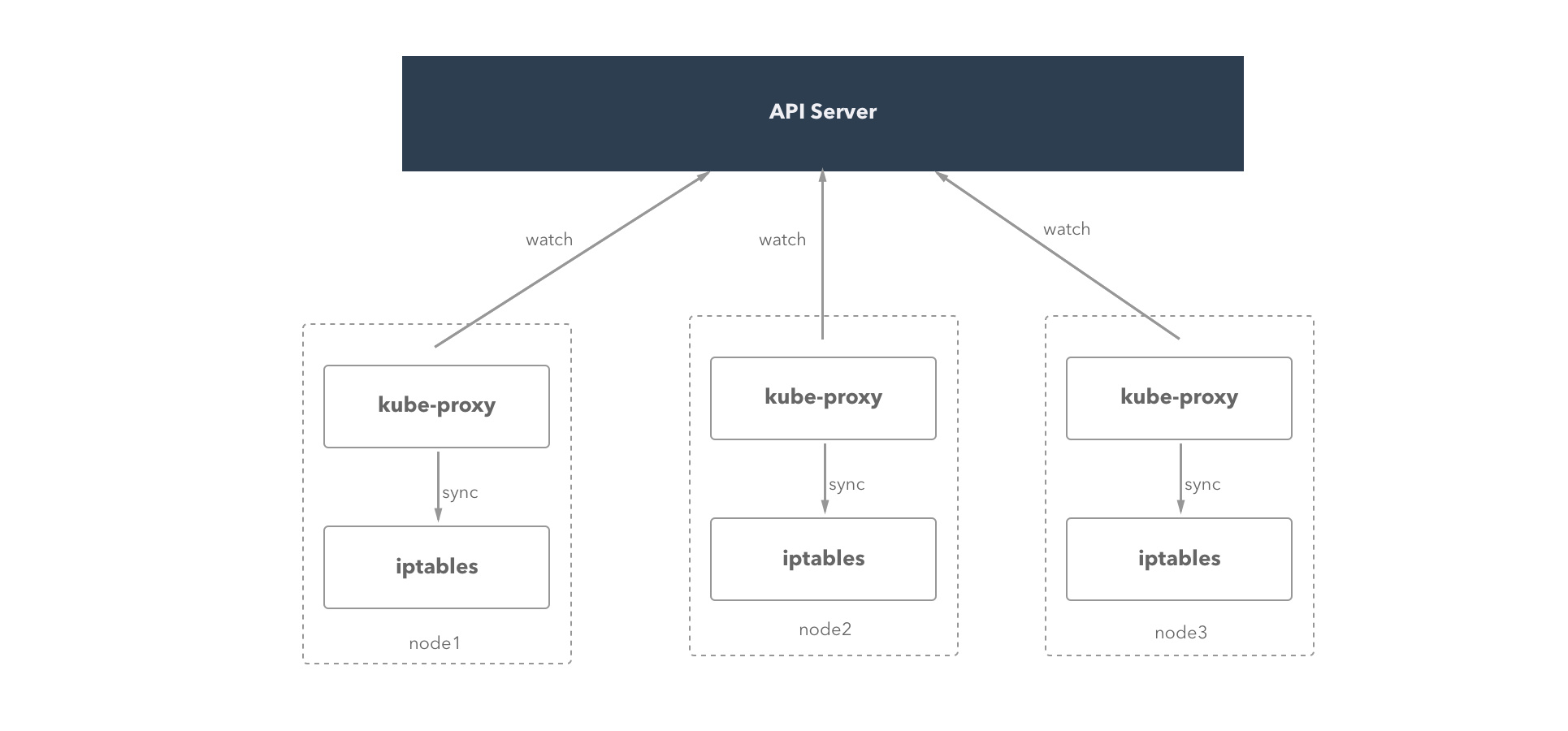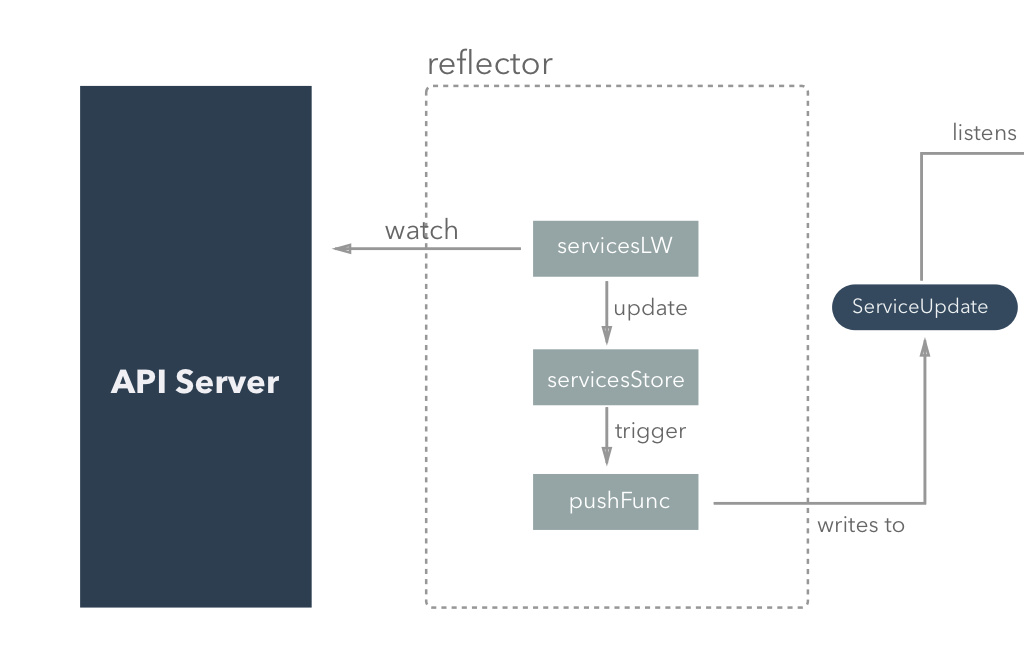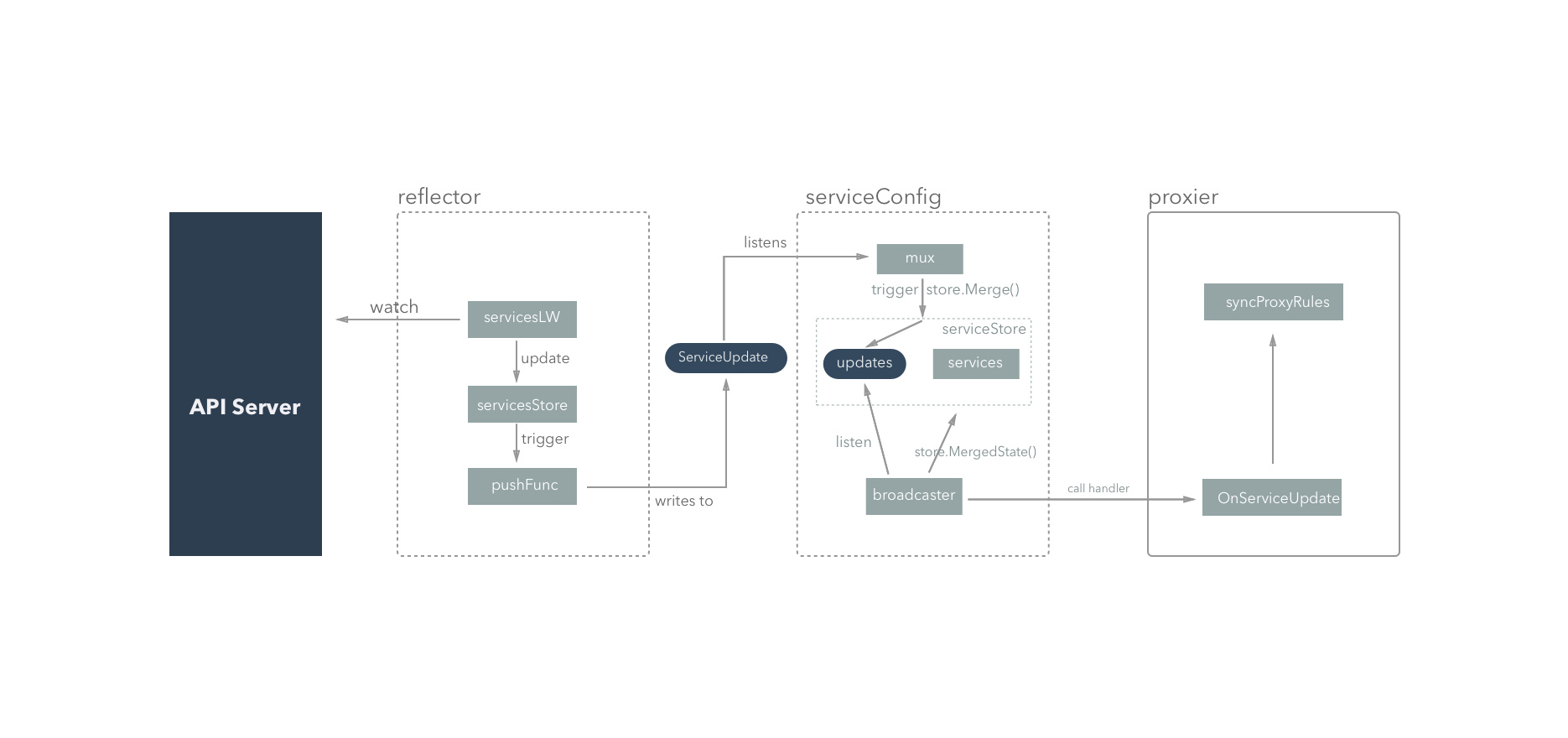kube-proxy 功能简介
我们在之前的文章中介绍过 kube-proxy 和 service的工作原理,以及它们的使用方法和功能。我们再来总结一下,kube-proxy 运行在 kubernetes 集群中每个 worker 节点上,负责实现 service 这个概念提供的功能。kube-proxy 会把访问 service VIP 的请求转发到运行的 pods 上,实现负载均衡。

当用户创建 service 的时候,endpointController 会根据 service 的 selector 找到对应的 pod,然后生成 endpoints 对象保存到 etcd 中。kube-proxy 的主要工作就是监听 etcd(通过 apiserver 的接口,而不是直接读取 etcd),来实时更新节点上的 iptables。
service 有关的信息保存在 etcd 的 /registry/services 目录,比如在我的集群中,这个目录的内容是这样的:
~]$ etcdctl ls --recursive /registry/services
/registry/services/endpoints
/registry/services/endpoints/default
/registry/services/endpoints/default/whoami
/registry/services/endpoints/default/kubernetes
/registry/services/endpoints/kube-system
/registry/services/endpoints/kube-system/kube-controller-manager
/registry/services/endpoints/kube-system/container-log
/registry/services/endpoints/kube-system/container-terminal
/registry/services/endpoints/kube-system/kube-scheduler
/registry/services/endpoints/kube-system/kube-dns
/registry/services/specs
/registry/services/specs/default
/registry/services/specs/default/kubernetes
/registry/services/specs/default/whoami
/registry/services/specs/kube-system
/registry/services/specs/kube-system/kube-dns
/registry/services/specs/kube-system/container-log
/registry/services/specs/kube-system/container-terminal
这篇文章我们会分析 kube-proxy 的源码,讲解在 iptables 模式下它的原理。文章所有的代码基于 kubernetes 1.5.0,为了增强可读性会对某些部分做删减(错误处理、日志打印、无关的功能等)。
函数入口
和 kubernetes 其他组件一样,kube-proxy 入口在 kubernetes/cmd/kube-proxy,具体的代码如下:
func main() {
config := options.NewProxyConfig()
config.AddFlags(pflag.CommandLine)
flag.InitFlags()
...
s, err := app.NewProxyServerDefault(config)
...
if err = s.Run(); err != nil {
fmt.Fprintf(os.Stderr, "%v\n", err)
os.Exit(1)
}
}
上述代码的大概过程是:用 options.NewProxyConfig() 创建出默认的配置选项,然后用命令行的参数更新配置的内容;然后 app.NewProxyServerDefault(config) 利用配置创建服务,最后运行创建的服务,一直保持运行状态。
服务创建
kube-proxy 入口很重要的一部分就是创建 ProxyServer,我们来看一下 app.NewProxyServerDefault(config) 内部的实现,这个函数定义是在 cmd/kube-proxy/app/server.go:
func NewProxyServerDefault(config *options.ProxyServerConfig) (*ProxyServer, error) {
...
protocol := utiliptables.ProtocolIpv4
if net.ParseIP(config.BindAddress).To4() == nil {
protocol = utiliptables.ProtocolIpv6
}
var netshInterface utilnetsh.Interface
var iptInterface utiliptables.Interface
var dbus utildbus.Interface
execer := exec.New()
...
// Create event recorder
hostname := nodeutil.GetHostname(config.HostnameOverride)
eventBroadcaster := record.NewBroadcaster()
recorder := eventBroadcaster.NewRecorder(api.EventSource{Component: "kube-proxy", Host: hostname})
var proxier proxy.ProxyProvider
var endpointsHandler proxyconfig.EndpointsConfigHandler
proxyMode := getProxyMode(string(config.Mode), client.Core().Nodes(), hostname, iptInterface, iptables.LinuxKernelCompatTester{})
if proxyMode == proxyModeIPTables {
if config.IPTablesMasqueradeBit == nil {
return nil, fmt.Errorf("Unable to read IPTablesMasqueradeBit from config")
}
proxierIPTables, err := iptables.NewProxier(iptInterface, utilsysctl.New(), execer, config.IPTablesSyncPeriod.Duration, config.IPTablesMinSyncPeriod.Duration, config.MasqueradeAll, int(*config.IPTablesMasqueradeBit), config.ClusterCIDR, hostname, getNodeIP(client, hostname))
proxier = proxierIPTables
endpointsHandler = proxierIPTables
...
} else {
glog.V(0).Info("Using userspace Proxier.")
...
}
serviceConfig := proxyconfig.NewServiceConfig()
serviceConfig.RegisterHandler(proxier)
endpointsConfig := proxyconfig.NewEndpointsConfig()
endpointsConfig.RegisterHandler(endpointsHandler)
proxyconfig.NewSourceAPI(
client.Core().RESTClient(),
config.ConfigSyncPeriod,
serviceConfig.Channel("api"),
endpointsConfig.Channel("api"),
)
...
conntracker := realConntracker{}
return NewProxyServer(client, config, iptInterface, proxier, eventBroadcaster, recorder, conntracker, proxyMode)
}
最终 NewProxyServer() 比较简单,把所有传给它的参数作为结构体的内容返回,这些参数中的解释如下:
client:连接到 kubernetes api server 的客户端对象config: proxyServer 配置对象,包含了所有的配置信息iptInterface: iptables 对象,运行执行所有的 iptables 操作proxier: proxier 是具体执行转发逻辑的对象,不管 userspace 模式还是 iptables 模式,都是一个 proxier 对象eventBroadcaster: 事件广播对象,把 kube-proxy 内部发生的事件发送到 apiserverrecorder: 事件记录对象conntracker: connection track 有关的操作proxyMode: 代理的模式,iptables 还是 userspace
这里面有两个比较重要的变量:proxier 和 endpointsHandler,它们的值都是 proxierIPTables。
ServiceConfig 和 endpointsConfig
serviceConfig 和 endpointsConfig 分别负责服务和端点相关内容的同步,它们的原理都是一样的。我们这里只分析 serviceConfig,它的代码在 pkg/proxy/config/config.go 文件中。serviceConfig 结构如下:
type ServiceConfig struct {
mux *config.Mux
bcaster *config.Broadcaster
store *serviceStore
}
它有三个结构:mux 是个汇聚器,可以把发送过来的更新统一保存到内部,serviceStore 保存了发生变化的 Service 对象,Broadcaster 在一旦有变化出现的时候通知对应的处理函数就行处理。
func NewServiceConfig() *ServiceConfig {
updates := make(chan struct{}, 1)
store := &serviceStore{updates: updates, services: make(map[string]map[types.NamespacedName]api.Service)}
mux := config.NewMux(store)
bcaster := config.NewBroadcaster()
go watchForUpdates(bcaster, store, updates)
return &ServiceConfig{mux, bcaster, store}
}
func watchForUpdates(bcaster *config.Broadcaster, accessor config.Accessor, updates <-chan struct{}) {
for true {
<-updates
bcaster.Notify(accessor.MergedState())
}
}
// 注册 handler,有变化的时候会调用对应的 handler 进行处理
func (c *ServiceConfig) RegisterHandler(handler ServiceConfigHandler) {
c.bcaster.Add(config.ListenerFunc(func(instance interface{}) {
glog.V(3).Infof("Calling handler.OnServiceUpdate()")
handler.OnServiceUpdate(instance.([]api.Service))
}))
}
上面这段代码可以看到 NewServiceConfig 初始化的时候会在后台启动一个 goroutine 运行 watchForUpdates,这个 goroutine 不断循环的逻辑就是上面提到的:一旦 updates 可读(service 对象有变化),就调用 bcaster.Notify() 把变化的内容(通过 accessor.MergedState() 函数得到的结果)进行通知,最终会调用在内部注册的 handler 函数。
NOTE: 这个注册-触发的逻辑是通过 Broadcaster 实现的,对应的代码在 pkg/util/config/config.go,它提供了两个方法:Add() 是添加 handler,可以添加多个;notify() 会把参数交给所有的 handler 进行处理。
注册 handler 的步骤是 serviceConfig.RegisterHandler(proxier),所以最终会调用 proxier.OnServiceUpdate()方法,这个方法就是 pkg/proxy/iptables/proxier.go:Proxier 定义的,会实现最终 iptables 规则的刷新。
说道这里,还有两者问题需要解决:变化的内容是怎么获得的?谁会往 updates channel 中写东西?
第一个问题的答案在 serviceStore.MergedState() 方法中:
func (s *serviceStore) MergedState() interface{} {
s.serviceLock.RLock()
defer s.serviceLock.RUnlock()
services := make([]api.Service, 0)
for _, sourceServices := range s.services {
for _, value := range sourceServices {
services = append(services, value)
}
}
return services
}
serviceStore 结构体内部用一个嵌套字典 map[string]map[types.NamespacedName]api.Service 保存了所有的 Service 对象,这个嵌套字典外层的键是来源,内层是对应的服务名和服务对象。MergedState 方法删除了最外层的来源,返回所有的 Service 对象,也就是起到了汇聚不同来源 Service 的功能。至于这个字典是谁在什么时候写进去的,我们后面再说。
第二个问题,我们要看下面这段代码的实现了:
proxyconfig.NewSourceAPI(
client.Core().RESTClient(),
config.ConfigSyncPeriod,
serviceConfig.Channel("api"),
endpointsConfig.Channel("api"),
)
NewSourceAPI 有四个参数,第一个参数是 RESTClient,用来从 apiserver 获取请求;后面两个参数分别是 service 和 endpoints 的 channel,读取的数据最终会发送到这里。我们还是来看一下 serviceConfig.Channel() 的代码:
func (c *ServiceConfig) Channel(source string) chan ServiceUpdate {
ch := c.mux.Channel(source)
serviceCh := make(chan ServiceUpdate)
go func() {
for update := range serviceCh {
ch <- update
}
close(ch)
}()
return serviceCh
}
这段代码创建了两个 channel:一个是在 c.mux 中创建的,用来汇聚所有的 service 对象,一个是新建的 ServiceUpdate channel,最终作为返回值。在后台启动一个参数,会把 ServiceUpdate channel 中的东西,持续不断地转送到 c.mux channel 中。也就是说,任何写到 serviceConfig.Channel("api") 的内容最终都会被 c.mux 调用 serviceStore.Merge(),这个方法会把 channel 中的更新保存到字典中 map[string]map[types.NamespacedName]api.Service。这个可以回答我们上面留下的疑问,serviceConfig 中的数据是谁写进去的。
func (s *serviceStore) Merge(source string, change interface{}) error {
s.serviceLock.Lock()
services := s.services[source]
if services == nil {
services = make(map[types.NamespacedName]api.Service)
}
update := change.(ServiceUpdate)
switch update.Op {
case ADD:
glog.V(5).Infof("Adding new service from source %s : %s", source, spew.Sdump(update.Services))
for _, value := range update.Services {
name := types.NamespacedName{Namespace: value.Namespace, Name: value.Name}
services[name] = value
}
case REMOVE:
glog.V(5).Infof("Removing a service %s", spew.Sdump(update))
for _, value := range update.Services {
name := types.NamespacedName{Namespace: value.Namespace, Name: value.Name}
delete(services, name)
}
case SET:
glog.V(5).Infof("Setting services %s", spew.Sdump(update))
// Clear the old map entries by just creating a new map
services = make(map[types.NamespacedName]api.Service)
for _, value := range update.Services {
name := types.NamespacedName{Namespace: value.Namespace, Name: value.Name}
services[name] = value
}
default:
glog.V(4).Infof("Received invalid update type: %s", spew.Sdump(update))
}
s.services[source] = services
s.serviceLock.Unlock()
if s.updates != nil {
// Since we record the snapshot before sending this signal, it's
// possible that the consumer ends up performing an extra update.
select {
case s.updates <- struct{}{}:
default:
glog.V(4).Infof("Service handler already has a pending interrupt.")
}
}
return nil
}
另外,在 ServiceStore 的最后,还会往 s.updates 写入一个数据,告诉监听在 channel 另一端说有数据更新,你可以调用处理函数来同步 iptables 了。
整个 serviceConfig 的逻辑是这样的:

它对外暴露了一个 channel,任何写到这个 channel 中的数据,都会被 mux 自动保存到内部的 serviceStore 中,并往 updates channel 发一个通过,监听在 updates channel 另一端的 bcaster 接到通知,就调用处理函数 proxier.OnServiceUpdate() 去处理。
不难猜测,在 NewSourceAPI 函数的内部一定会有把读取的数据写到 serviceConfig.Channel("api") 的逻辑。
NOTE: endpointsConfig 和 serviceConfig 的实现原理完全一样,只不过监听的对象是 etcd 中的 endpoints,而不是 services。
NewSourceAPI 和数据的真实来源
上面这部分我们看到了如果监听到的对象有变化,会执行对应的 iptables 同步处理函数,这部分我们讲讲 kube-proxy 是怎么监听 apiserver 的数据,并把结果转换成正确的格式的。
继续看 NewSourceAPI 的代码:
func NewSourceAPI(c cache.Getter, period time.Duration, servicesChan chan<- ServiceUpdate, endpointsChan chan<- EndpointsUpdate) {
servicesLW := cache.NewListWatchFromClient(c, "services", api.NamespaceAll, fields.Everything())
cache.NewReflector(servicesLW, &api.Service{}, NewServiceStore(nil, servicesChan), period).Run()
endpointsLW := cache.NewListWatchFromClient(c, "endpoints", api.NamespaceAll, fields.Everything())
cache.NewReflector(endpointsLW, &api.Endpoints{}, NewEndpointsStore(nil, endpointsChan), period).Run()
}
NewServiceAPI 为 service 和 endpoints 分别创建了 ListWatch 和 Reflector,根据惯例,我们还是只分析 Service 有关的部分。
cache.NewListWatchFromClient() 方法定义在 pkg/client/cache/listwatch.go 文件,它主要的功能是从 apiserver 读取(list)和监听(watch)某个 uri 地址的数据。它的实现不是本文的重点,在此略过不表,有兴趣可以自行阅读,并不是很复杂。
NewServiceStore 是什么的呢?
func NewServiceStore(store cache.Store, ch chan<- ServiceUpdate) cache.Store {
fn := func(objs []interface{}) {
var services []api.Service
for _, o := range objs {
services = append(services, *(o.(*api.Service)))
}
ch <- ServiceUpdate{Op: SET, Services: services}
}
if store == nil {
store = cache.NewStore(cache.MetaNamespaceKeyFunc)
}
return &cache.UndeltaStore{
Store: store,
PushFunc: fn,
}
}
Reflector 会从 ListWatcher 中读取要监听资源的变化,写到 store 对象中去。这部分的代码在 pkg/client/cache/ ,不是本文的重点。简单说一下它的大致过程:它内部进入循环,调用 servicesLW.wathc() 方法,根据得到的数据更新 serviceStore 的值,这个 serviceStore 每次更新都会出发一个 pushFunc 把当前的数据写到 channel ServiceUpdate ,从而完成了和上面部分的对接!

OnServiceUpdate:最终干活的人
前面说了数据是怎么从 api Server 被 kube-rpoxy 拿到,并一层层地传递的。最终拿到了 service 和 endpoints 的数据,最终还是要落到谁来处理这些数据。前面我们也提过,不管是 iptables 模式,还是 userspace 模式,最终的处理函数都是 OnServiceUpdate(),我们这里还是看一下 iptables/proxier.go:OnServiceUpdate:
func (proxier *Proxier) OnServiceUpdate(allServices []api.Service) {
proxier.mu.Lock()
defer proxier.mu.Unlock()
proxier.haveReceivedServiceUpdate = true
activeServices := make(map[proxy.ServicePortName]bool) // use a map as a set
for i := range allServices {
service := &allServices[i]
svcName := types.NamespacedName{
Namespace: service.Namespace,
Name: service.Name,
}
for i := range service.Spec.Ports {
servicePort := &service.Spec.Ports[i]
serviceName := proxy.ServicePortName{
NamespacedName: svcName,
Port: servicePort.Name,
}
activeServices[serviceName] = true
info, exists := proxier.serviceMap[serviceName]
if exists && proxier.sameConfig(info, service, servicePort) {
continue
}
if exists {
glog.V(3).Infof("Something changed for service %q: removing it", serviceName)
delete(proxier.serviceMap, serviceName)
}
serviceIP := net.ParseIP(service.Spec.ClusterIP)
glog.V(1).Infof("Adding new service %q at %s:%d/%s", serviceName, serviceIP, servicePort.Port, servicePort.Protocol)
info = newServiceInfo(serviceName)
info.clusterIP = serviceIP
info.port = int(servicePort.Port)
info.protocol = servicePort.Protocol
info.nodePort = int(servicePort.NodePort)
info.externalIPs = service.Spec.ExternalIPs
// Deep-copy in case the service instance changes
info.loadBalancerStatus = *api.LoadBalancerStatusDeepCopy(&service.Status.LoadBalancer)
info.sessionAffinityType = service.Spec.SessionAffinity
info.loadBalancerSourceRanges = service.Spec.LoadBalancerSourceRanges
proxier.serviceMap[serviceName] = info
glog.V(4).Infof("added serviceInfo(%s): %s", serviceName, spew.Sdump(info))
}
}
staleUDPServices := sets.NewString()
// Remove serviceports missing from the update.
for name, info := range proxier.serviceMap {
if !activeServices[name] {
glog.V(1).Infof("Removing service %q", name)
if info.protocol == api.ProtocolUDP {
staleUDPServices.Insert(info.clusterIP.String())
}
delete(proxier.serviceMap, name)
}
}
proxier.syncProxyRules()
proxier.deleteServiceConnections(staleUDPServices.List())
}
这段代码的核心是遍历作为参数传进来的 api.Service 数组,根据里面的信息构建 proxier.serviceMap(service 有改动,或者新建、删除),然后调用 proxier.syncProxyRules() 去同步 iptables 规则列表。
通过这个部分的分析,我们明白了 kube-proxy 是如何保证 apiserver 中数据一旦变化,就立即更新节点的 iptables 规则的。
这个过程的流程图如下:

服务的运行
ProxyServer 初始化结束之后,还会调用 s.Run(),我们来看一下里面的内容:
func (s *ProxyServer) Run() error {
// Start up a webserver if requested
if s.Config.HealthzPort > 0 {
http.HandleFunc("/proxyMode", func(w http.ResponseWriter, r *http.Request) {
fmt.Fprintf(w, "%s", s.ProxyMode)
})
configz.InstallHandler(http.DefaultServeMux)
go wait.Until(func() {
err := http.ListenAndServe(s.Config.HealthzBindAddress+":"+strconv.Itoa(int(s.Config.HealthzPort)), nil)
if err != nil {
glog.Errorf("Starting health server failed: %v", err)
}
}, 5*time.Second, wait.NeverStop)
}
// Tune conntrack, if requested
if s.Conntracker != nil && runtime.GOOS != "windows" {
max, err := getConntrackMax(s.Config)
if err != nil {
return err
}
if max > 0 {
err := s.Conntracker.SetMax(max)
if err != nil {
if err != readOnlySysFSError {
return err
}
const message = "DOCKER RESTART NEEDED (docker issue #24000): /sys is read-only: " +
"cannot modify conntrack limits, problems may arise later."
s.Recorder.Eventf(s.Config.NodeRef, api.EventTypeWarning, err.Error(), message)
}
}
if s.Config.ConntrackTCPEstablishedTimeout.Duration > 0 {
timeout := int(s.Config.ConntrackTCPEstablishedTimeout.Duration / time.Second)
if err := s.Conntracker.SetTCPEstablishedTimeout(timeout); err != nil {
return err
}
}
if s.Config.ConntrackTCPCloseWaitTimeout.Duration > 0 {
timeout := int(s.Config.ConntrackTCPCloseWaitTimeout.Duration / time.Second)
if err := s.Conntracker.SetTCPCloseWaitTimeout(timeout); err != nil {
return err
}
}
}
// Birth Cry after the birth is successful
s.birthCry()
// Just loop forever for now...
s.Proxier.SyncLoop()
return nil
}
这是个会一直运行的函数,前面的部分主要给 kube-proxy 做一些额外的补充,比如启动 healthz web 服务器,优化 conntrack 的参数。最后会调用 s.Proxier.SyncLoop() 进入主循环。
func (proxier *Proxier) Sync() {
proxier.mu.Lock()
defer proxier.mu.Unlock()
proxier.syncProxyRules()
}
func (proxier *Proxier) SyncLoop() {
t := time.NewTicker(proxier.syncPeriod)
defer t.Stop()
for {
<-t.C
glog.V(6).Infof("Periodic sync")
proxier.Sync()
}
}
这是一个周期性的任务,每隔 proxier.syncPeriod 的时间周期(默认是 30s,可以通过启动参数 --iptables-sync-period 配置)就会调用 proxier.syncProxyRules() 对 iptables 进行更新。
这里有个疑问:既然 kube-proxy 能够自动监听 apiserver 的变化,并更新 iptables,为什么这里还要再每隔一段时间强制同步一次呢?我的看法是这只是安全防护措施,来规避有些情况(比如代码 bug,或者网络、环境问题等原因)下数据可能没有及时同步。
